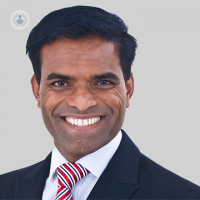Stage four endometriosis: should I have surgery first or a baby?
Written by:A recent comparative study shows surgery outcomes in a relatively large number of patients presenting with rectovaginal endometriosis which are discussed in this article.

We recently spoke with leading gynaecologist, Mr Mahantesh Karoshi , to talk about the stages of endometriosis, particularly stage four. Read on to find out how stage four endometriosis should be treated, how effective surgery is for treating it, and whether getting pregnant can help reduce the symptoms of this painful condition.
What are the different stages of endometriosis?
Stages of endometriosis can be based on the location, depth, amount and size of the endometrial tissue.
Stage 1: There are few small clumps of tissue (called implants). They may be found in the tissue lining abdomen or pelvis, it'¡s considered ‘minimal’, though pain can vary.
Stage 2: There are more implants than in stage one. They also have more tissue, there may also be some scar tissue. The endometriosis is considered ‘mild’.
Stage 3: It’s the presence of superficial peritoneal endometriosis, it’s deeply invasive with moderate to extensive adhesions.
Stage 4: At this stage, there’s severe adhesions and a large number of cysts. Small cysts may be found on the back wall of the uterus and rectum.
How severe is stage four endometriosis and how should it be treated?
Some patients can have debilitating symptoms with this condition, others may be totally symptom free.
Endometriosis affects women during their reproductive life span, some women in stage four may have rectovaginal endometriosis (RVE).
RVE is a severe form of deep endometriosis that is associated with pain and infertility. The situation will arise where we would have to make a decision whether to perform surgery, first to optimise their fertility chances, or do nothing, i.e., manage it conservatively.
How effective is surgery?
Up until now, some surgical groups favoured surgery to optimise fertility. However, a large Finnish study shows conservatively managed women do equally well compared to women who underwent surgery to respect the deep infiltrating endometriotic nodules.
In the Finnish Study, there were two groups as expected one group went ahead with conservative management and the other group underwent surgical excision of endometriosis. The Finnish authors demonstrated that there are no differences noted in in either the clinical pregnancy rate or the live birth rate.
Systematic reviews have reported on the relationship between placenta previa and deep infiltrating endometriosis. Several studies have shown a relationship between placenta previa and the location of the endometriosis. The incidence of placenta previa in patients with deep endometriosis is around 11% as compared to 0.5%.
So, to conclude, even though accurate diagnosis of endometriosis is important, when it comes to managing deep seated endometriosis, sit tight and try for pregnancy seems to be the mantra.
Can getting pregnant actually reduce symptoms of endometriosis?
Pregnancy can actually heal some of these identified nodules because of the hormones produced specifically when pregnant.
For more information, we recommend getting in touch with a highly experienced consultant gynaecologist such as Mr Mahantesh Karoshi. Click here to visit his Top Doctors profile today for more information on his expertise and appointment availability.


